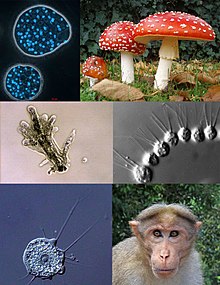Amorphea
(Aangestuur vanaf Unikonta)
Amorphea[1] is lede van 'n taksonomiese supergroep wat Amoebozoa en Obazoa insluit. Die laasgenoemde bevat die Opisthokonta, wat Swamme, Diere en die Choanomonada, of Choanoflagellatea insluit. Die taksonomiese affiniteite van die lede van hierdie klade is oorspronklik beskryf en voorgestel deur Thomas Cavalier-Smith in 2002.[2][4]
| Amorphea | |
|---|---|

| |
| Kloksgewys, van links bo: Abeoforma whisleri (Ichthyosporea); Amanita muscaria (Fungi); Desmarella moniliformis (Choanoflagellatea); Bonnet Macaque (Metazoa); Nuclearia thermophila (Nucleariida); Amoeba proteus (Amoebozoa) | |
| Wetenskaplike klassifikasie | |
| Domein: | Eukaryota |
| (geen rang): | Amorphea Adl et al., 2012[1] |
| Subgroepe | |
| Sinonieme | |
Die "International Society of Protistologists", die erkende liggaam vir taksonomie van protosoë, het in 2012 aanbeveel dat die term Unikont verander word na Amorphea omdat die naam "Unikont" gebaseer is op 'n veronderstelde synapomorfie wat die ISP-outeurs en ander wetenskaplikes later verwerp het.[1][5]
Dit sluit in amoebozoa, opisthokonts,[6][7] en moontlik Apusozoa.[8]
Verwysings
wysig- ↑ 1,0 1,1 1,2 Adl SM, Simpson AG, Lane CE, Lukeš J, Bass D, Bowser SS, Brown MW, Burki F, Dunthorn M, Hampl V, Heiss A, Hoppenrath M, Lara E, Le Gall L, Lynn DH, McManus H, Mitchell EA, Mozley-Stanridge SE, Parfrey LW, Pawlowski J, Rueckert S, Shadwick RS, Schoch CL, Smirnov A, Spiegel FW (September 2012). "The revised classification of eukaryotes". J Eukaryot Microbiol. 59 (5): 429–93. doi:10.1111/j.1550-7408.2012.00644.x. PMC 3483872. PMID 23020233.
- ↑ 2,0 2,1 Cavalier-Smith T (Maart 2002). "The phagotrophic origin of eukaryotes and phylogenetic classification of Protozoa". Int. J. Syst. Evol. Microbiol. 52 (Pt 2): 297–354. doi:10.1099/00207713-52-2-297. PMID 11931142. Geargiveer vanaf die oorspronklike op 29 Julie 2017. Besoek op 5 Mei 2022.
- ↑ Derelle, Romain; Torruella, Guifré; Klimeš, Vladimír; Brinkmann, Henner; Kim, Eunsoo; Vlček, Čestmír; Lang, B. Franz; Eliáš, Marek (17 Februarie 2015). "Bacterial proteins pinpoint a single eukaryotic root". Proceedings of the National Academy of Sciences (in Engels). 112 (7): E693–E699. Bibcode:2015PNAS..112E.693D. doi:10.1073/pnas.1420657112. PMC 4343179. PMID 25646484.
- ↑ Cavalier-Smith, Thomas (2003). "Protist phylogeny and the high-level classification of Protozoa". European Journal of Protistology. 39 (4): 338–348. doi:10.1078/0932-4739-00002.
- ↑ Roger AJ, Simpson AG (2009). "Evolution: revisiting the root of the eukaryote tree". Current Biology. 19 (4): R165–R167. doi:10.1016/j.cub.2008.12.032. PMID 19243692. S2CID 13172971.
- ↑ A Minge M, Silberman JD, Orr RJ, et al. (November 2008). "Evolutionary position of breviate amoebae and the primary eukaryote divergence". Proc. Biol. Sci. 276 (1657): 597–604. doi:10.1098/rspb.2008.1358. PMC 2660946. PMID 19004754.
- ↑ Burki F, Pawlowski J (Oktober 2006). "Monophyly of Rhizaria and multigene phylogeny of unicellular bikonts". Mol. Biol. Evol. 23 (10): 1922–30. doi:10.1093/molbev/msl055. PMID 16829542.
- ↑ Glücksman E, Snell EA, Berney C, Chao EE, Bass D, Cavalier-Smith T (September 2010). "The Novel Marine Gliding Zooflagellate Genus Mantamonas (Mantamonadida ord. n.: Apusozoa)". Protist. 162 (2): 207–221. doi:10.1016/j.protis.2010.06.004. PMID 20884290.